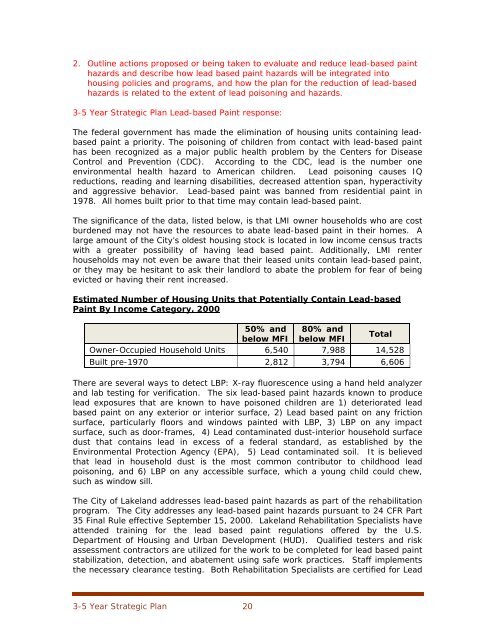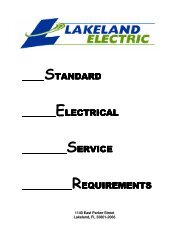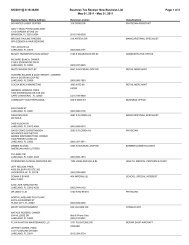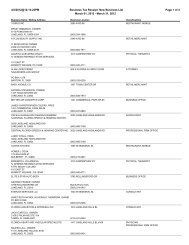CONSOLIDATED PLAN & STRATEGY 5-YEAR ... - City of Lakeland
CONSOLIDATED PLAN & STRATEGY 5-YEAR ... - City of Lakeland
CONSOLIDATED PLAN & STRATEGY 5-YEAR ... - City of Lakeland
Create successful ePaper yourself
Turn your PDF publications into a flip-book with our unique Google optimized e-Paper software.
2. Outline actions proposed or being taken to evaluate and reduce lead-based paint<br />
hazards and describe how lead based paint hazards will be integrated into<br />
housing policies and programs, and how the plan for the reduction <strong>of</strong> lead-based<br />
hazards is related to the extent <strong>of</strong> lead poisoning and hazards.<br />
3-5 Year Strategic Plan Lead-based Paint response:<br />
The federal government has made the elimination <strong>of</strong> housing units containing leadbased<br />
paint a priority. The poisoning <strong>of</strong> children from contact with lead-based paint<br />
has been recognized as a major public health problem by the Centers for Disease<br />
Control and Prevention (CDC). According to the CDC, lead is the number one<br />
environmental health hazard to American children. Lead poisoning causes IQ<br />
reductions, reading and learning disabilities, decreased attention span, hyperactivity<br />
and aggressive behavior. Lead-based paint was banned from residential paint in<br />
1978. All homes built prior to that time may contain lead-based paint.<br />
The significance <strong>of</strong> the data, listed below, is that LMI owner households who are cost<br />
burdened may not have the resources to abate lead-based paint in their homes. A<br />
large amount <strong>of</strong> the <strong>City</strong>’s oldest housing stock is located in low income census tracts<br />
with a greater possibility <strong>of</strong> having lead based paint. Additionally, LMI renter<br />
households may not even be aware that their leased units contain lead-based paint,<br />
or they may be hesitant to ask their landlord to abate the problem for fear <strong>of</strong> being<br />
evicted or having their rent increased.<br />
Estimated Number <strong>of</strong> Housing Units that Potentially Contain Lead-based<br />
Paint By Income Category, 2000<br />
50% and 80% and<br />
below MFI below MFI<br />
Total<br />
Owner-Occupied Household Units 6,540 7,988 14,528<br />
Built pre-1970 2,812 3,794 6,606<br />
There are several ways to detect LBP: X-ray fluorescence using a hand held analyzer<br />
and lab testing for verification. The six lead-based paint hazards known to produce<br />
lead exposures that are known to have poisoned children are 1) deteriorated lead<br />
based paint on any exterior or interior surface, 2) Lead based paint on any friction<br />
surface, particularly floors and windows painted with LBP, 3) LBP on any impact<br />
surface, such as door-frames, 4) Lead contaminated dust-interior household surface<br />
dust that contains lead in excess <strong>of</strong> a federal standard, as established by the<br />
Environmental Protection Agency (EPA), 5) Lead contaminated soil. It is believed<br />
that lead in household dust is the most common contributor to childhood lead<br />
poisoning, and 6) LBP on any accessible surface, which a young child could chew,<br />
such as window sill.<br />
The <strong>City</strong> <strong>of</strong> <strong>Lakeland</strong> addresses lead-based paint hazards as part <strong>of</strong> the rehabilitation<br />
program. The <strong>City</strong> addresses any lead-based paint hazards pursuant to 24 CFR Part<br />
35 Final Rule effective September 15, 2000. <strong>Lakeland</strong> Rehabilitation Specialists have<br />
attended training for the lead based paint regulations <strong>of</strong>fered by the U.S.<br />
Department <strong>of</strong> Housing and Urban Development (HUD). Qualified testers and risk<br />
assessment contractors are utilized for the work to be completed for lead based paint<br />
stabilization, detection, and abatement using safe work practices. Staff implements<br />
the necessary clearance testing. Both Rehabilitation Specialists are certified for Lead<br />
3-5 Year Strategic Plan 20
















